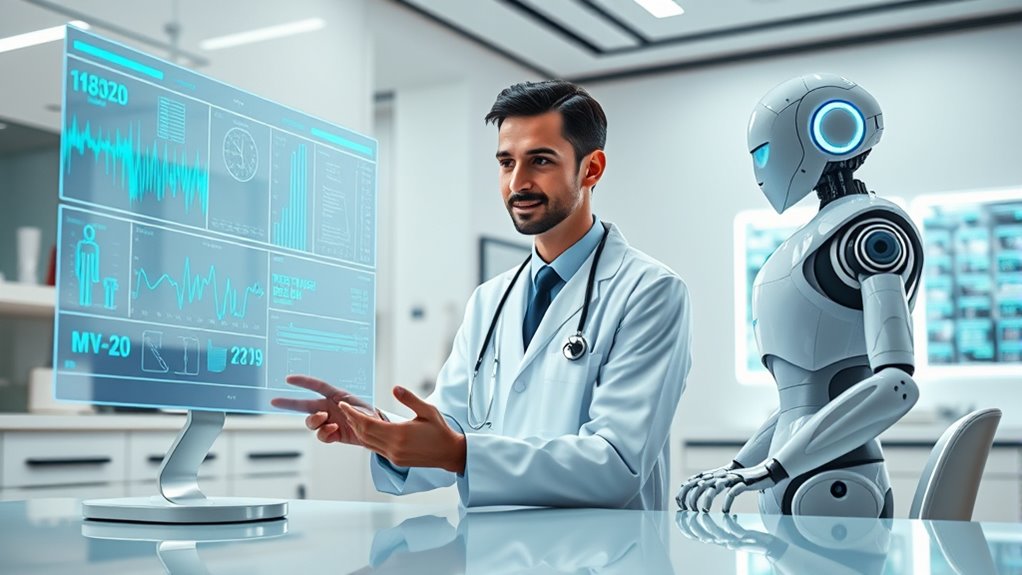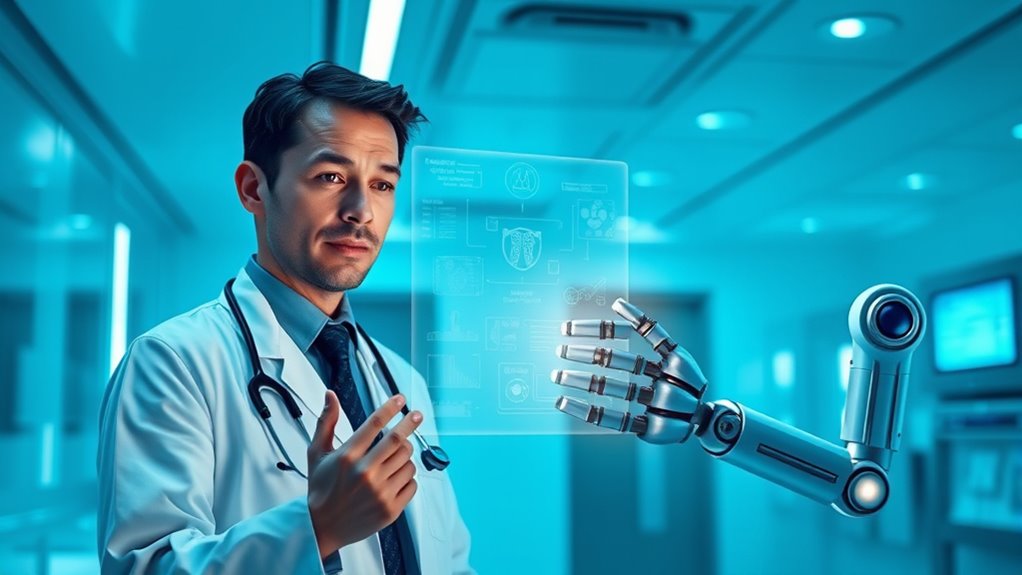The future of medicine is all about humans and machines working together. Advanced AI and digital tools will support healthcare professionals by improving diagnosis, treatment, and patient care. These technologies help handle data, reduce workload, and provide personalized support, making healthcare more accurate and accessible. While machines handle analysis and routine tasks, human qualities like empathy remain essential. Explore how this collaboration continues to reshape the healthcare landscape and creates new possibilities.
Key Takeaways
- Human-machine collaboration enhances diagnostic accuracy and efficiency, leading to more personalized and effective healthcare.
- AI-powered telehealth and intelligent systems support remote monitoring and emotional care, expanding access to quality services.
- Machines handle data analysis and repetitive tasks, allowing healthcare professionals to focus on holistic patient care.
- Ongoing integration of AI fosters interdisciplinary teamwork, improving decision-making and treatment outcomes.
- The partnership between humans and machines drives innovation, making medicine more precise, efficient, and patient-centered.

The future of medicine is increasingly shaped by collaboration between humans and machines, where advanced technologies augment healthcare professionals’ capabilities. This partnership boosts diagnostic accuracy and efficiency, with recognition rates surpassing 90% in tasks like human posture recognition. Deep learning-powered multimodal fusion methods enable thorough health assessments, capturing complex conditions that traditional methods might miss and improving predictions. Tele-health monitoring, enhanced by AI, allows for more precise and efficient remote patient care through intelligent interaction systems that adapt to individual needs. Companion robots, analyzing real-time physiological data and providing emotional support, help improve mental health and treatment adherence. These technologies are essential in personalizing treatments and optimizing resource use, especially as populations age and healthcare demands grow. Moreover, incorporating patient-centered approaches ensures that technological advancements serve to enhance the overall patient experience and outcomes.
You’ll notice that AI isn’t here to replace doctors anytime soon. Instead, it acts as a powerful tool that enhances your diagnostic and treatment capabilities, particularly in fields like radiology, pathology, and dermatology. While machines handle data analysis and repetitive tasks, your human qualities—empathy, complex decision-making, and holistic care—remain indispensable. AI helps reduce your workload by automating administrative chores, giving you more time to focus on patient interaction and care. This collaboration promises to improve healthcare access, especially in underserved areas, and address workforce shortages by enabling more efficient service delivery.
As this partnership evolves, your role will shift toward high-level decision-making and interdisciplinary collaboration alongside AI systems. You’ll utilize machine insights to make better-informed choices, ensuring personalized and precise treatments. However, integrating these technologies also presents challenges—performance can vary depending on the context, and there’s ongoing debate about how best to optimize human-AI teamwork. Despite mixed results, what’s clear is that embracing this collaboration will transform medicine into a more accurate, efficient, and patient-centered field. By working together with machines, you’ll open new possibilities for healthcare, ultimately providing better outcomes for your patients and the broader community.
Frequently Asked Questions
How Will Patient Privacy Be Protected With Increased Machine Involvement?
You’ll see patient privacy protected through robust safeguards like data anonymization, access controls, and audit logs. Privacy-preserving techniques such as federated learning and differential privacy help maintain data security during AI training. Regular staff training, strict role-based access, and transparent policies build trust. These measures ensure sensitive information remains confidential, even as machine involvement increases, balancing innovation with the essential need to respect patient privacy.
What Training Will Doctors Need to Work With Medical AI?
You’ll need training in understanding AI concepts like machine learning and data handling, so you can interpret diagnostic tools accurately. It’s essential to learn ethical principles, including informed consent and privacy protections, to safeguard patient rights. You’ll also benefit from practical skills on integrating AI into workflows seamlessly, ensuring it complements your expertise without causing deskilling. Continuous education and certification will keep you confident and competent in evolving AI technologies.
Will Machine Errors Be Harder to Detect Than Human Errors?
Machine errors can be like hidden shadows, more difficult to spot than human errors. You might find it harder to detect them because AI systems often operate as a black box, with less transparency. While machine errors can slip by undetected, human errors are usually easier to trace through reasoning. As a result, you’ll need to stay vigilant, combining human intuition with machine oversight to catch errors effectively.
How Accessible Will Advanced Medical Collaborations Be Globally?
Advanced medical collaborations will become more accessible globally, but disparities remain. You’ll find that regions with better infrastructure, like high-speed internet and modern healthcare facilities, will adopt these technologies faster. In emerging markets, investments in telemedicine, AI tools, and digital literacy programs will bridge gaps over time. However, access depends on economic factors, policy support, and international partnerships, making equitable healthcare collaboration an ongoing challenge in low- and middle-income countries.
What Are the Ethical Concerns of Relying on Machines for Diagnosis?
You face ethical concerns when relying on machines for diagnosis: risking patient privacy, risking data misuse, perpetuating bias, and compromising transparency. You must consider how algorithms might unfairly target vulnerable groups or produce inaccurate results. You also need to guarantee patients are informed and consent, maintain human empathy and connection, and establish clear accountability. Balancing technological advances with ethical responsibility is essential to protect patient rights, trust, and equitable care.
Conclusion
You might worry that machines will replace doctors, but that’s not the case. Instead, they’ll enhance your care, giving your doctor more tools and insights to help you better. When humans and machines work together, you get more accurate diagnoses, personalized treatments, and faster recoveries. This collaboration isn’t about replacing the human touch; it’s about empowering your healthcare experience. Together, we’re building a future where medicine is more compassionate, precise, and accessible for everyone.










